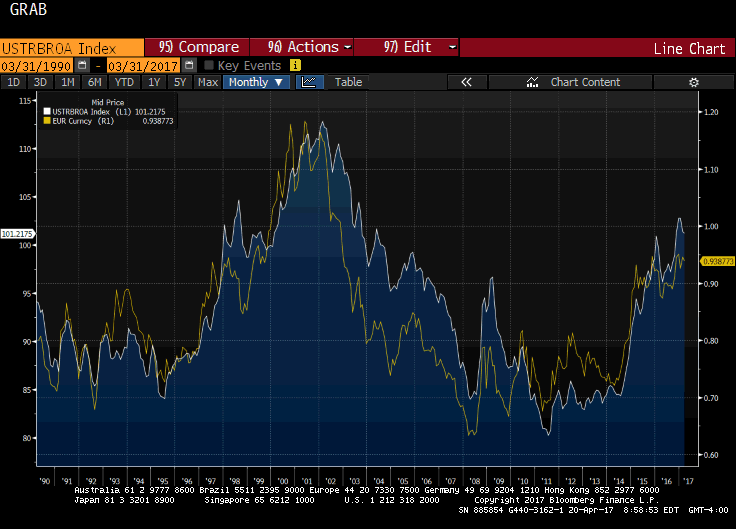Summary:
The dollar market is intact, despite the pullback here at the start of 2017.
We have seen similar pullbacks in 2016 and 2015.
Divergence remains the key driver.
The Federal Reserve’s real broad trade-weighted dollar fell for the first three months of 2017, and the greenback’s heavy tone this month has raised questions about the state of the bull market. Despite this recent weakness, we think the bull market is intact and that the advance will resume.
In the February through April last year, the real broad trade-weighted measure of the dollar fell. Many investors doubted the bull market was intact. The greenback proceeded to rally seven of the following eight months. In 2015, this measure of the dollar fell in three of the 12 months, and two were back-to-back (April and May). In 2014, there was a three-month losing streak (March-May). It then appreciated in six of the following seven months. Of course, history does not repeat itself.
| The Great Graphic here depicts the real broad trade-weighted index(white line) and the euro (yellow line). The chart goes back to 1990. I am uncomfortable showing two time series on two scales on a single chart, as this practice seems abused on Wall Street. However, for given this, the two track each other pretty closely and for good fundamental reasons. Europe is a significant US trade partner and shares many of the same drivers of headline inflation, like energy.
To assess the dollar’s bull market in a disciplined fashion, and to avoid getting caught up in short-run disruptions, we come back to our assessment of the driver. We argue that first significant dollar rally post-Bretton Woods (the Reagan dollar rally) was driven by the policy mix of loose fiscal policy and tight monetary policy (under Volcker). The second dollar rally (Clinton dollar rally) was driven by the carving out of the internet (leading to the tech bubble)/ We note that the Fed began raising rates in 1994 and the dollar’s bull market began in the spring of 1995. |
Trade-Weighted Index and the Euro, 1990 - 2017(see more posts on Swiss Franc Index, ) |
We see the current dollar rally (Obama-Trump), the third since Bretton Woods. What allowed us to anticipate it was our understanding of the driver: Divergence of monetary policy broadly understood. The Federal Reserve responded early and aggressively to the financial crisis. It began its unorthodox policies in 2009, several years before the Bank of Japan and the ECB began their efforts. This, coupled with the flexibility of the US economy, produced results earlier, allowing the Fed to exit and begin normalizing policy before most of the rest of the world.
The question of the state of the dollar bull market is a question, in our mind, of whether divergence remains intact. We think it does. Softer Q1 GDP, with the pullback in consumption, we judge as a temporary soft patch. Growth in the January-March period has been typically soft beginning in 2010. From 2010 through 2016, growth in Q1 has averaged 1.1%. Growth in all the other quarters has averaged 2.5%.
The key to consumption is income. Wages are an important part of income. More people are working earning a little bit more per hour. This can be expected to continue to underpin consumption on a trend basis. The recovery of the oil patch should support business investment. Over the past year, exports have grown four times faster than the growth of the overall economy. Despite the past dollar rally, the trade deficit has not deteriorated and remains near its 12- and 24-months.
Investors may have gotten ahead of themselves in anticipating that President Trump’s economic agenda of deregulation, tax reform, and infrastructure spending would boost growth. The legislative agenda, as opposed to executive orders, is proving more difficult than many assumed given the Republican majorities. On the other hand, as noted by the Fed’s Vice Chairman Fischer earlier this week, and concurring with the IMF, the global economy is in somewhat better shape.
We argue that Fed policy has entered a new phase. It is more confident in the resilience of the economy. It will bring a new tool to bear in the normalization process later this year or early next year: the balance sheet. Meanwhile, the BOJ’s Kuroda has confirmed what our contacts in Japan had hinted. Asset purchases in Japan will continue for “some time.”
We suspect the next move from the ECB (next week) may be to tweak the securities lending program which may help increase the ability of the ECB to continue is asset purchases. The fact that core inflation is still stuck in the trough (0.6% after bottoming in 2015 at 0.5%) despite the various unorthodox policies. By the time the ECB being raising their negative 40 bp deposit rate the Fed may have hiked rates 1-2 more times. The Fed may begin reducing its balance sheet while the ECB and BOJ expand theirs.
The political situation is admittedly very fluid. A trade war, perhaps precipitated by the border adjustment tax (BAT), or a currency war, spurred by attempts by President Trump to talk the dollar down, could diminish the role of divergence as a driver of the Obama-Trump dollar rally. We don’t think we are there yet. The odds do not seem to favor Senate approval of BAT, and Treasury Secretary Mnuchin has been quick to do damage control of Trump’s comments about the dollar.
Full story here Are you the author? Previous post See more for Next postTags: #USD,$EUR,$JPY,Great Graphic,newslettersent,Swiss Franc Index









































